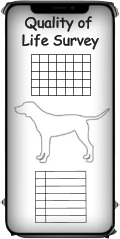Wellbeing has become a major interest to dog owners, veterinarians, and a wide range of dog product and service providers.
The increasing attention for the dog-owner relationship combined with advances in nutrition and veterinary care have made wellbeing a focal point for dog owners, veterinarians, and dog product and service providers. While canine wellbeing can be quantified by survey-based quality of life instruments like those used in human healthcare, there are currently few instruments available that can do this reliably and at scale.
Development of a Quality of Life (QOL) Survey Tool for General Use
Researchers from the UK and US have published a report on the development and initial validation of a canine quality of life instrument specifically designed to quantify wellbeing in the general dog population. The instrument is based on a simple 32-question survey and includes:
- 5 daytime domains (energetic, mobile, relaxed, happy, sociable)
- 3 mealtime domains (relaxed, interested and satisfied).
- Specific health-related aspects as well as more general wellbeing aspects.
The initial sample of 2813 dogs, already provides useful insights on canine wellbeing. We believe that data collection at scale with this instrument will help bring optimal wellbeing to the dogs we care for.
Dogs have played a key role in society for centuries, over which the nature of dog ownership has continually evolved. The past decade has seen a particularly dramatic shift with owners increasingly seeing their dog as a family member1 and seeking out products and services like those they would use for themselves. In parallel, advancements in veterinary care have reduced the prevalence of communicable disease and have seen and increase in chronic conditions such as periodontal disease and obesity the most common health conditions. Because of these evolutions, wellbeing has become of major interest to dog owners, veterinarians, and a wide range of dog product and service providers.
The primary objective of this study is to develop a comprehensive canine QoL instrument that can serve a wide range of applications and is amenable to large scale data collection. In addition, the aim is to demonstrate instrument validity and conduct an initial characterization of wellbeing in a large sample of dogs. 
Refinement of the QOL Scale Continues
As a note of caution, these population-level effects do not necessarily imply that the instrument will work at the level of individual dogs or will detect changes over time. Therefore, further studies with well- characterized dogs and prospective longitudinal data collection are still required. Yet all things considered, initial validity tests show clear promise and support the instrument being used in practical studies to further document its validity, for example by linking results to concurrent biological measurements, behavior analysis and clinical diagnosis.
Given that the survey is filled in by the dog owner it is unclear whether this genuinely reflects the dogʼs wellbeing or includes unconscious bias from the dog owner. However, given the importance of the ownerʼs perception of their petʼs wellbeing in deciding to seek or continue care this information nevertheless provides valuable insights. In any case these findings support the link between health and wellbeing and demonstrate that the instrument can quantify owner-perceived wellbeing effects that are critical in the management of chronic diseases.
Potential Uses
Pending further positive validation results our plan is to deploy this instrument at a large scale taking advantage of the fact that its simple structure allows it to be completed in 3 to 5 min and makes it easy to integrate in a wide range of apps. At that scale it will be possible to develop granular reference ranges (e.g. life stage specific) allowing dog owners to benchmark and monitor their dogʼs wellbeing and intervene when deemed necessary. The authors believe that this instrument can improve veterinary care. A survey completed prior to examination can make the consultation more efficient and reveal issues that could otherwise have gone unnoticed, while routine post-visit data collection can provide information for outcome evaluation and support delivery of value- based care. More generally the survey will help everyone involved in improving dogʼs lives (pet owners, veterinarians, service providers, the pet food nutrition industry, etc.) ensure that their efforts bring optimal wellbeing to the dogs they care for.
